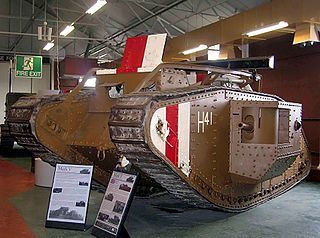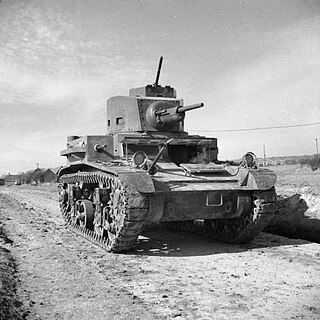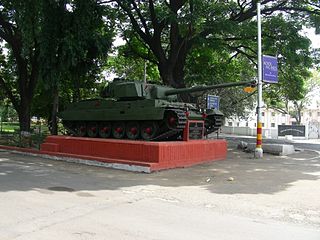Related Research Articles

An armoured fighting vehicle or armored fighting vehicle (AFV) is an armed combat vehicle protected by armour, generally combining operational mobility with offensive and defensive capabilities. AFVs can be wheeled or tracked. Examples of AFVs are tanks, armoured cars, assault guns, self-propelled artilleries, infantry fighting vehicles (IFV), and armoured personnel carriers (APC).

An amphibious vehicle is a vehicle that works both on land and on or under water. Amphibious vehicles include amphibious bicycles, ATVs, cars, buses, trucks, railway vehicles, combat vehicles, and hovercraft.

The 7TP was a Polish light tank of the Second World War. It was developed from the British Vickers 6-ton. A standard tank of the Polish Army during the 1939 Polish Campaign, its production did not exceed 150 vehicles. Its chassis was used as the base for the C7P artillery tractor.

The Type 94 tankette was a tankette used by the Imperial Japanese Army in the Second Sino-Japanese War, at Nomonhan against the Soviet Union, and in World War II. Although tankettes were often used as ammunition tractors, and general infantry support, they were designed for reconnaissance, and not for direct combat. The lightweight Type 94 proved effective in China as the Chinese National Revolutionary Army had only three tank battalions to oppose them, and those tank battalions were equipped only with some British export models and Italian CV-33 tankettes. As with nearly all tankettes built in the 1920s and 1930s, they had thin armor that could be penetrated by .50 caliber (12.7 mm) machine gun fire at 600 yards (550 m) range.

The Tank, Infantry, Mk III, Valentine was an infantry tank produced in the United Kingdom during World War II. More than 8,000 Valentines were produced in eleven marks, plus specialised variants, accounting for about a quarter of wartime British tank production. The variants included riveted and welded construction, petrol and diesel engines and increases in armament. It was supplied in large numbers to the USSR and built under licence in Canada. It was used by the British in the North African campaign. Developed by Vickers, it proved to be strong and reliable.

The Universal Carrier, also known as the Bren Gun Carrier and sometimes simply the Bren Carrier from the light machine gun armament, is a common name describing a family of light armoured tracked vehicles built by Vickers-Armstrongs and other companies.

The M2 light tank, officially Light Tank, M2, was an American light tank of the interwar period which saw limited service during World War II. The most common model, the M2A4, was equipped with one 37 mm (1.5 in) M5 gun and five .30 cal M1919 Browning machine guns.

The Light Tank Mark I to Mark V were a series of related designs of light tank produced by Vickers for the British Army during the interwar period.

The 3rd Armoured Division was an armoured unit of the Australian Army during World War II. Originally raised in 1921 as the 1st Cavalry Division, the formation had been converted into a motor division in early 1942, before adopting the armoured designation in November 1942. A Militia formation, the division undertook garrison duties in New South Wales and then Queensland and did not see combat before being disbanded in late 1943 and early 1944.

The Goliath tracked mine was a series of two unmanned ground vehicles used by the German Army as disposable demolition vehicles during World War II. These were the electrically powered Sd.Kfz. 302 and the petrol-engine powered Sd.Kfz. 303a and 303b. They were known as "beetle tanks" by the Allies.

The Vickers MBT is a series of main battle tanks (MBTs) developed as a private venture by British company Vickers-Armstrongs for export. The design makes use of proven components, such as the L7 gun of the Centurion, the Leyland L60 multi-fuel engine, the transmission and fire control system of the Chieftain. Many copied tanks were also built by India under licence as the Vijayanta.

The Vijayanta was a main battle tank built in India based on a licensed design of the Vickers Mk.1. The Vijayanta was the first indigenous tank of the Indian Army.

The M1 combat car, officially Light Tank, M1, was a light tank used by the United States Cavalry in the late 1930s and developed at the same time as the U.S. Army Infantry Branch's very similar Light Tank, M2.

The M13 multiple gun motor carriage (MGMC), otherwise known as the M13 half-track, was a self-propelled anti-aircraft gun used by the U.S. Army during World War II that was armed with two .50 caliber M2HB heavy-barrel Browning machine guns. Developed in response to a requirement for a mobile anti-aircraft (AA) vehicle, the vehicle was produced by the White Motor Company between July 1942 and May 1943. The only time it was ever used in combat was when the Americans landed at Anzio in January 1944. It was replaced by the more heavily armed M16 multiple gun motor carriage in April 1944.
Christopher Frank Foss is a British military information author. Between 1970-2017, he worked for the military information publisher Jane's Information Group as editor of Janes Armour and Artillery, Jane’s Armoured Fighting Vehicles, Jane's AFV System Upgrades and co-editor of other Jane's editions such as Jane’s Artillery and Air Defence and Jane's Military Vehicles and Logistics. After stepping back in late 2017, Foss stayed on as a Consulting Editor with Janes for Jane's Defence Weekly and Jane's International Defence Review until late 2021. Since then he has continued writing articles for other military information publishers such as Shepard Media. During his career at Janes he was responsible for launching Jane’s Defence Review which later spun off into Jane's Soviet Intelligence Review and later Jane's Intelligence Review.
The Vickers Main Battle Tank Mark 7 was a main battle tank developed on the basis of a joint venture between Vickers Defence Systems in the United Kingdom and Krauss-Maffei of Germany. It combined the Leopard 2 chassis with the Universal Turret previously developed for the Vickers Valiant main battle tank. The Vickers Mk. 7 was a key milestone in the development of the Challenger 2 as many of the features developed and successfully demonstrated in the turret of the Vickers Mk. 7 were later incorporated into the Challenger 2.
References
- Ogorkiewizc, R M (April 1957). "Anti-tank Guided Missiles". The Royal Armoured Corps Journal. XI (2): 69.
- Everett, H. R. (13 November 2015), Unmanned Systems of World Wars I and II, MIT Press, pp. 476–477, ISBN 9780262331760 – via Google Books
- Foss, Christopher F; McKenzie, Peter (1988). The Vickers Tanks: From Landships to Challenger. Patrick Stephens Limited. pp. 130–131. ISBN 1-85260-141-8.